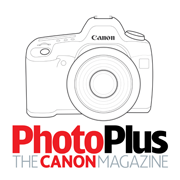Digital Camera World Verdict
Make no mistake, the EOS 77D is a great camera. The picture quality is fi rst rate and it has all the features and controls needed to satisfy photo enthusiasts. We particularly love its performance in Live View mode, where it feels as fast and responsive as the latest generation of mirrorless cameras. However, it does feel like a range-filler rather than a genuinely new camera, using tech already available in the EOS 80D. It’s not cheap, either.
Pros
- +
Excellent image quality
- +
45-point autofocus system
- +
Great Live View AF performance
- +
Touchscreen interface
Cons
- -
A little plasticky for its price
- -
No 4K video
- -
Good but not stellar continuous shooting speed
Why you can trust Digital Camera World
A couple of years ago, Canon launched the EOS 750D and 760D at the same time. While the two cameras were virtually identical to look at, and sported pretty much the same internal feature set, the 760D offered more body-mounted controls and a small LCD display on the top, designed to appeal to more experienced users.
Fast-forward two years and Canon has done the same thing again, launching the Canon EOS 77D alongside the more beginner-orientated 800D. Things are a little different this time, though. The EOS 77D may share the same internal features as the 800D, but Canon has opted for a more distinctive and slightly larger design for the 77D to differentiate the two models.
Key specifications
• Sensor: 24.2Mp APS-C (22.3x14.9mm) Dual Pixel CMOS AF
• Image processor: DIGIC 7
• AF points: 45, all cross-type
• ISO range: 100-25,600 (51,200 exp)
• Max image size: 6000x4000 pixels
• Metering zones: 63
• HD video: 1920x1080 up to 60fps
• Viewfinder: Pentamirror, 95% coverage
• Memory card: SD/SDHC/SDXC, UHS I
• LCD: 3-inch vari-angle touchscreen
• Top-plate LCD: Yes
• Max burst: 6fps
• Connectivity: Wi-Fi, NFC, Bluetooth
• Shutter speeds: 30-1/4000 sec, Bulb
• Size: 131x99.9x76.2mm (body only)
• Weight: 540g (with battery and card)
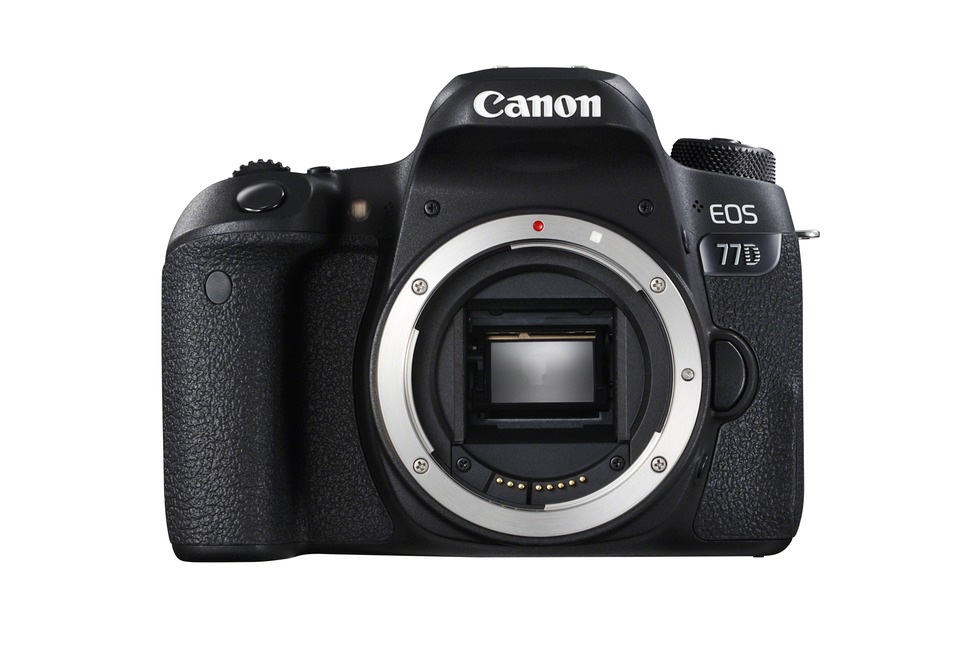

This review was first published in issue 128 of PhotoPlus magazine. You can subscribe to PhotoPlus here.
If you look under the skin of the EOS 77D, it’s pretty much identical to the EOS 800D. That means it gets the new 24.2MP APS-C CMOS sensor, which uses Canon’s latest sensor technology based on the same on-chip analogue-to-digital conversion tech as seen on the likes of the EOS 5D Mark IV, thus producing cleaner images at higher ISOs compared to the older sensor in the 750D and 760D.
Even without this, the EOS 77D promises to handle noise better at higher sensitivities, thanks to the arrival of a new DIGIC 7 image processor with a native ISO range of 100-25,600 that can be pushed another stop further to an ISO equivalent of 51,200 (you’ll have to dive into the menu to access this setting). In addition, the DIGIC 7 processor also offers improved autofocus performance when compared to the DIGIC 6 chip.
Like the EOS 800D, the EOS 77D uses a three-inch, vari-angle touchscreen display with a resolution of 1,040,000 dots. It’s disappointing not to see 4K video on the EOS 77D, especially given Canon’s heritage in this area – and considering 4K video is becoming an increasingly standard feature at this level from other brands.
Instead, you get Full HD capture up to 60p, while the EOS 77D also sports Canon’s new five-axis image stabilization system for shooting handheld footage. This in-camera system is designed for videos only – Canon isn’t ditching its lens-based image stabilization system, but IS optics will be able to work in tandem with the in-camera system for video if you want.
The EOS 77D supports Wi-Fi and NFC connectivity, while there’s also the option to set up a low-energy Bluetooth connection so you can always be connected to the camera. This enables you to remotely wake the camera from its sleep mode (provided you haven’t turned the camera fully off), as well as browse photos and operate the camera remotely from your smart device.
Build and handling
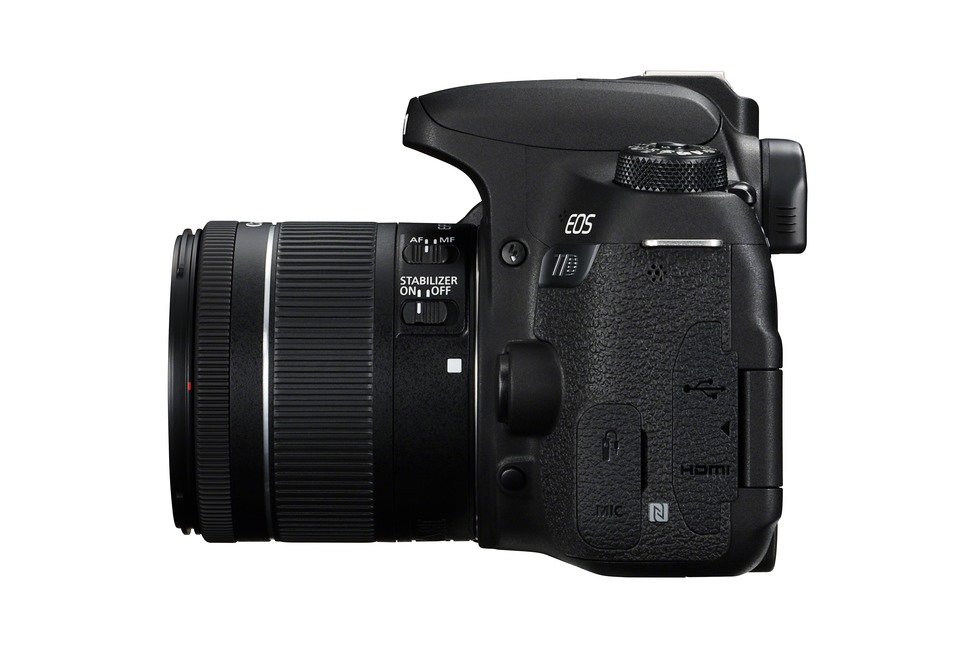
If the EOS 800D and more enthusiast-orientated EOS 80D had a baby, the EOS 77D would be it, sitting neatly in between the two in the range. The build and finish of the EOS 77D is most closely related to that of the 800D, though, with a similar combination of aluminium alloy and polycarbonate resin – in fact, it only weighs 8g more than the 800D.
It shares the 800D’s ultra-smooth finish on the majority of the exterior, which feels quite plasticky to the touch and at odds with the camera’s price. That said, the grip is comfortable and the textured finish has a nice tactile feel. The number of body-mounted controls is where the real differences between the EOS 77D and 800D become noticeable, starting with the top-plate LCD display, which the cheaper camera lacks.
It’s smaller than the top-plate LCD on the EOS 80D, but still provides a handy quick reference point for a host of key shooting information, including ISO setting, aperture and shutter speed, exposure compensation, battery level, Wi-Fi activation and the number of shots remaining.
In front of this display are dedicated controls for ISO and AF, as well as a button to illuminate the LCD in poor light. The positioning of the LCD display means the Mode dial moves to the left of the viewfinder, and unlike on the 800D it features a locking mechanism; you’ll need to press and hold the central button to spin the Mode dial around to the desired setting.
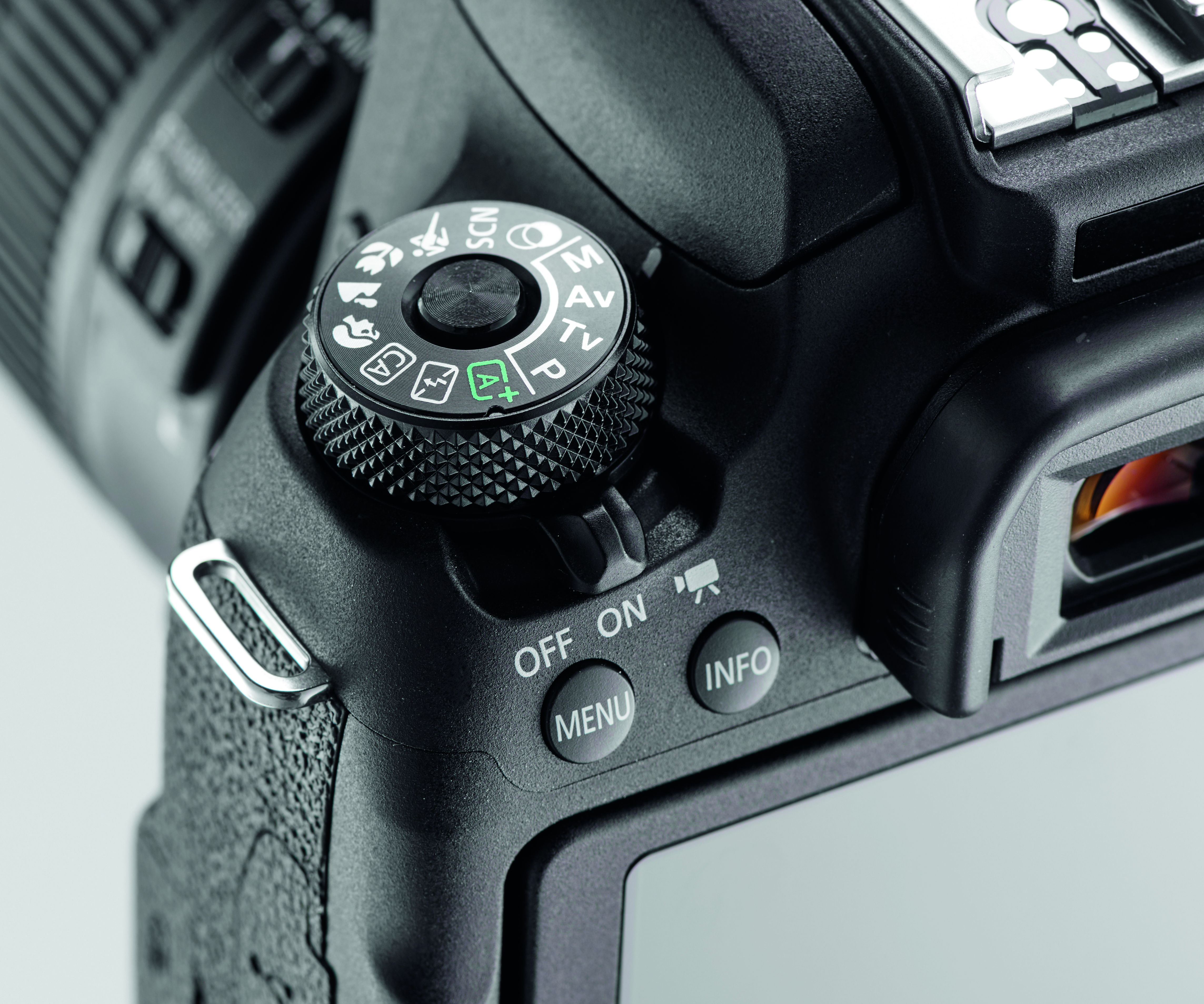
Moving round the back, there’s a dedicated AF-On button for back-button focusing, which can be really handy if you regularly shoot using continuous focusing. Rather than the 800D’s four-way control pad, the EOS 77D features a multi-directional control pad encircled by a scroll wheel; this mirrors some higher-end EOS DSLRs, enabling you to quickly toggle key settings, and it’s handy when the camera is raised to your eye.
Then there’s the EOS 77D’s touchscreen interface. We may have liked to have seen something a bit larger, and/or with more resolution, but there’s no quibbling about its functionality. It’s nicely integrated into the camera’s interface, works really well and is one of the most polished examples we’ve seen.
There’s also an optical viewfinder with 95% coverage; this is typical for an entry-level DSLR, but with the EOS 77D having loftier aspirations it’s a little disappointing, especially with similarly priced rivals offering 100% coverage. While it might not seem that much of a difference, you’ll be surprised at how unwanted elements can encroach on the edges of the frame when you review your images.
Autofocus
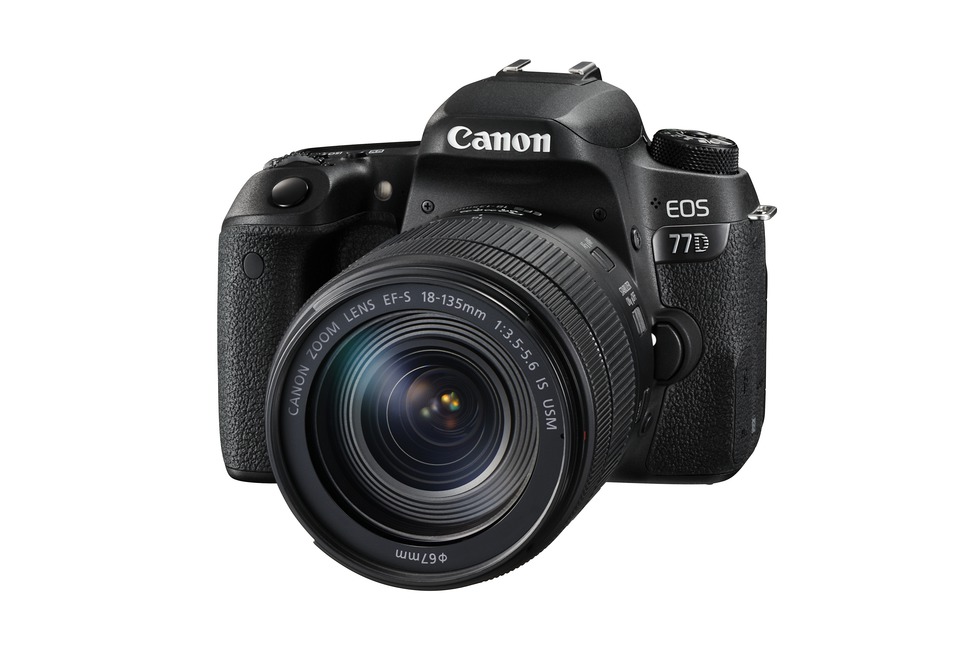
Like the 800D, the EOS 77D takes advantage of a 45-point AF system with all cross-type sensors, which are sensitive in both the horizontal and vertical planes to deliver more accurate focusing. The setup here is a welcome boost over the EOS 760D’s modest 19 AF points.
The EOS 77D’s autofocus system is also sensitive down to -3EV, so when light levels drop you should still be able to lock focus on poorly lit subjects. Of those 45 focus points, 27 are sensitive down to f/8, and while it might not be a key selling point for a lot of photographers, this can be handy if you’re shooting with a lens that has a maximum aperture of f/4 and you’ve paired it with a 2x teleconverter, as you’ll still be able to take advantage of those 27 points.
As we’ve found with the 800D, which uses the same phase-detect AF system, this array does a very good job. Focusing speed was very prompt, locking on briskly to our desired target in One Shot AF mode, even in poor light with the new 18-55mm STM lens fitted.

When it comes to shooting in continuous (AI Servo) AF mode and tracking a moving subject, there’s a noticeable boost in performance over the 760D’s 19-point arrangement. It’s more reliable than the older 19-point system, and the EOS 77D also uses its 7560-pixel RGB+IR metering sensor to help track subjects across the frame.
It will still mis-focus the odd shot in a sequence, though, and there’s no real customization on offer – for instance, it’s not possible to tell the EOS 77D’s AF system that you want the bias to be towards the front or rear of the frame. While models higher up the EOS food chain feature a dedicated joystick for AF point selection, the EOS 77D relies on the multi-directional control pad and scroll wheel to do this.
For Live View and video recording the EOS 77D uses Canon’s proven Dual Pixel AF technology, which offers 80% coverage of the frame. We’ve seen this system in a host of recent Canon cameras, such as the EOS 5D Mark IV and EOS M5, and we’ve never failed to be impressed by how well it works. It’s easily the best system in a DSLR, delivering snappy focusing, even if you want to track a (moderately fast) moving subject.
Performance
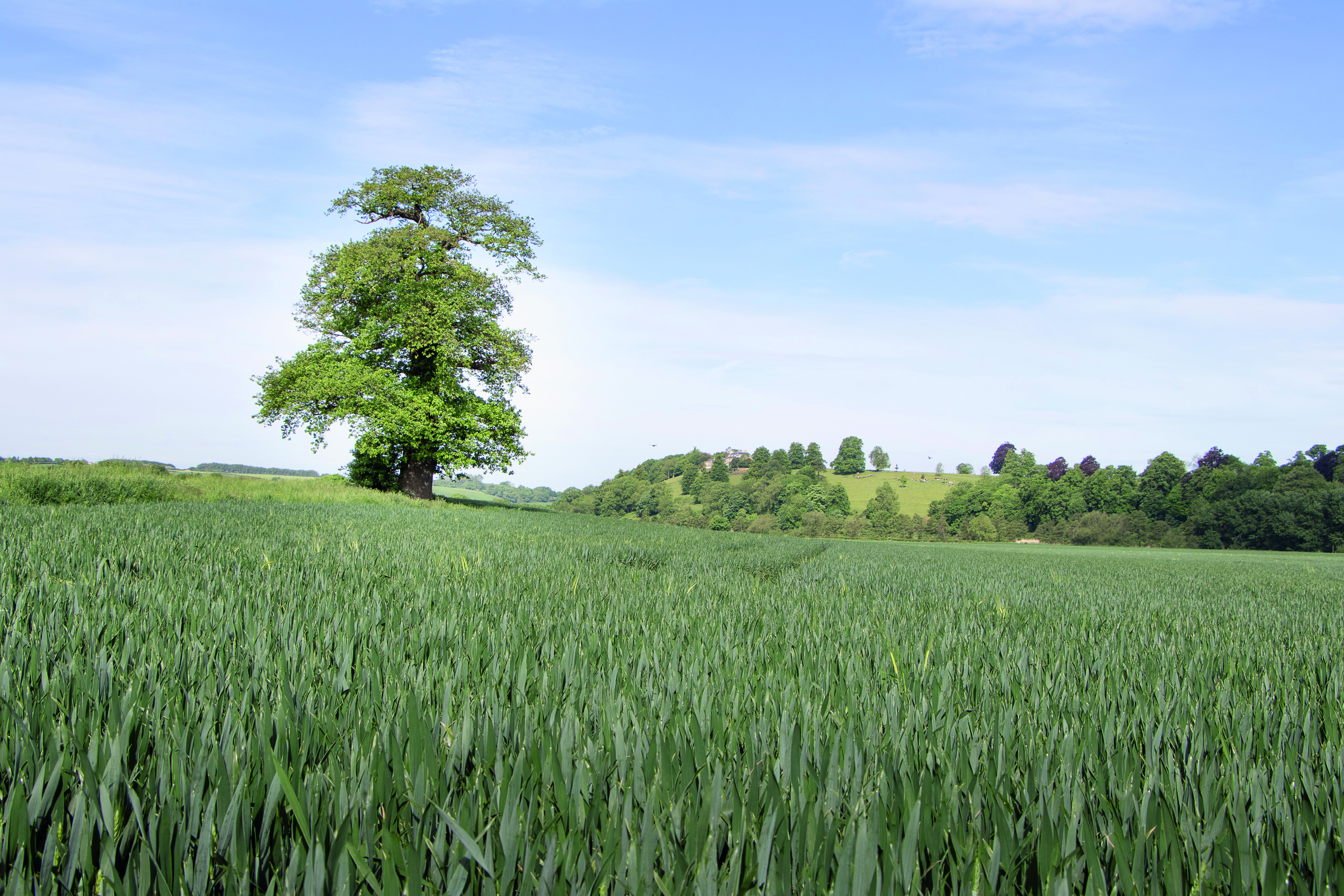
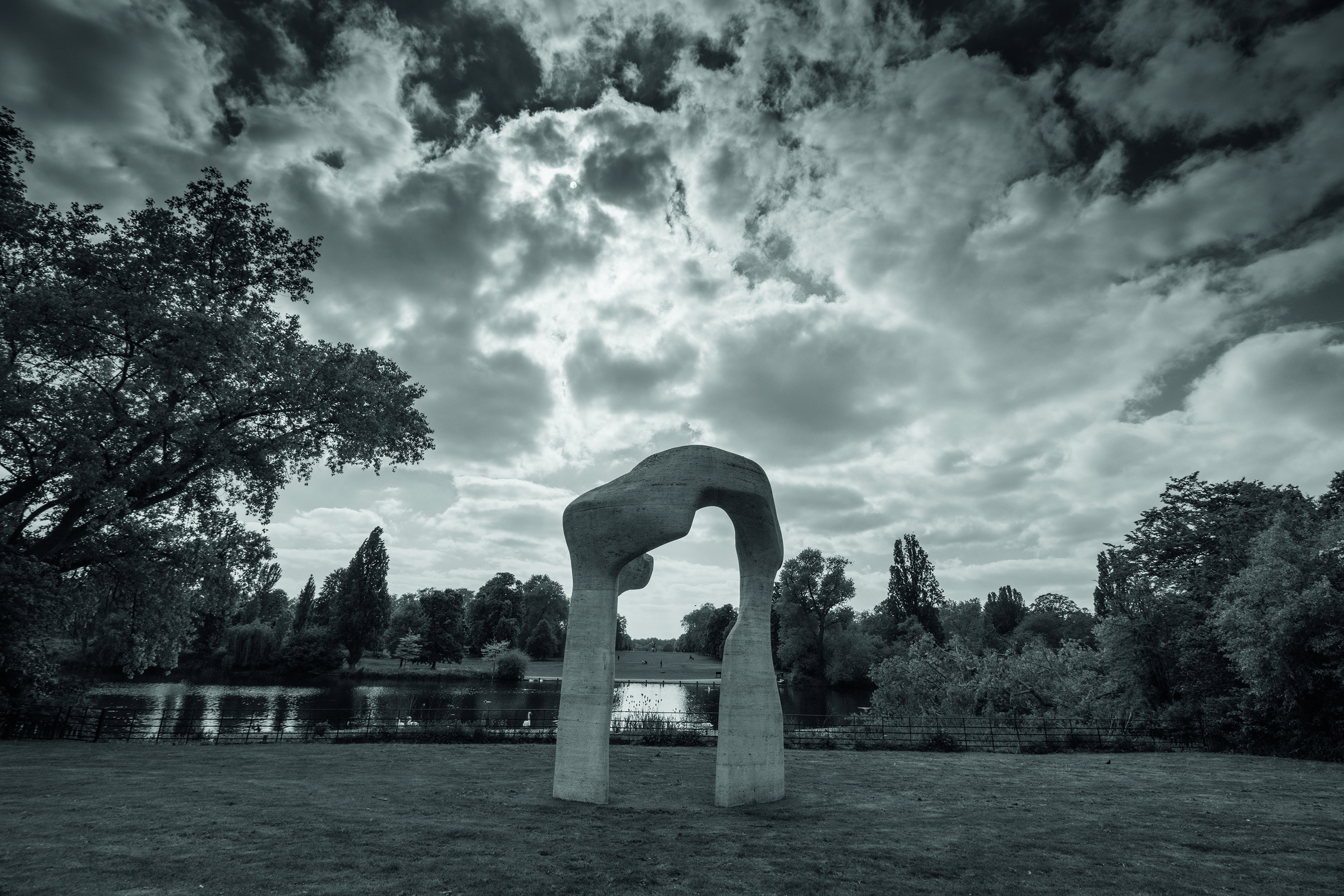


Like the EOS 800D, the EOS 77D can rattle off shots at 6fps – anything faster would risk the new camera treading on the toes of the EOS 80D’s 7fps. Battery life is good at 600 shots, although you’ll want to keep a spare handy if you plan to shoot predominantly with the rear display activated, as this will see battery life drop to 270 shots.
Also like the 800D, the EOS 77D takes advantages of Canon’s new clean-looking graphical interface, which is designed to help inexperienced users get to grips with some of the camera’s key controls. Where the cameras differ is that you have to turn this feature on in the display settings of the EOS 77D, whereas it’s the default mode of the 800D.
The EOS 77D sports Canon’s tried-and-tested 7560-pixel RGB+IR metering sensor, which we’ve seen in numerous Canon DSLRs (it’s also in the EOS 800D), with 63-zone Evaluative, Partial, Centre-weighted and Spot metering options.
For the most part the Evaluative mode will be the one you’ll be using, and it does a good job. As we’ve found with other EOS cameras though, because the system is weighted to the active AF point you can run into issues in high-contrast situations, as simply shifting the AF point can throw up two different exposures – some of our shots were a little overexposed for our liking.
The white balance system performs very well, while the option of an Ambient Auto White Balance mode has its uses, delivering slightly warmer results that can be welcome, while the default White Priority can deliver clean, neutral results even under artificial lighting.
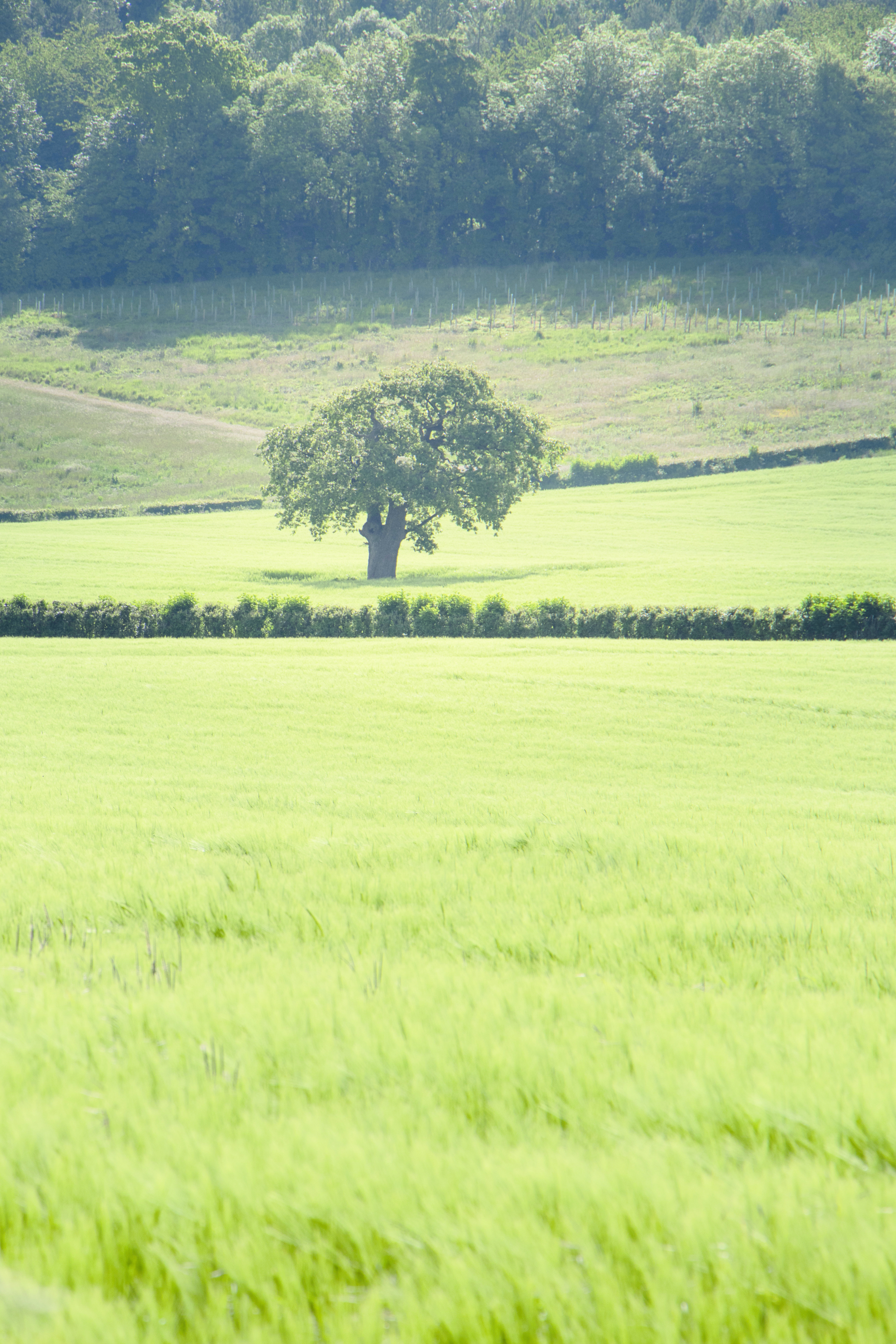
Canon’s new 24Mp APS-C CMOS sensor, as we’ve seen with the 800D, performs very well. Resolution is pretty much identical to the results from the older 760D – which is hardly a surprise when you consider that they share the same pixel count – but it’s elsewhere that the new sensor design shines, particularly the way the camera handles noise.
At lower sensitivities shots appeared very clean with good levels of saturation, but it’s when you start increasing the ISO that the EOS 77D’s sensor really impresses. Looking at Raw files edited in Adobe Camera Raw, our test images looked very pleasing to the eye, even at ISO6400. Granted, there’s some luminance (grain-like) noise present, but it’s well controlled and has a fine structure. There’s hardly any chroma (colour) noise present, and while saturation suffers a touch at this sensitivity, the overall result is very good.
Knock the sensitivity up another couple of notches, to ISO25,600, and saturation and detail deteriorate, while noise becomes very noticeable. We’d avoid using this setting where possible, although images will still be just about usable if you have to shoot in poor light and it’s your only option.
Dynamic range is better than we’ve seen from the older 760D, and the EOS 77D delivers pleasing JPEG colours, though they can perhaps look a little muted when up against rivals with punchier colour output. If you want to give your JPEGs a little more ‘bite’, opt for one of the picture styles, or shoot Raw for complete control.
Lab tests
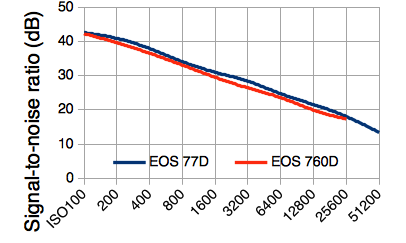
RAW Signal-to-noise ratio:
The 77D produces slightly better noise figures than the 760D, but the difference is so small as to be insignificant.
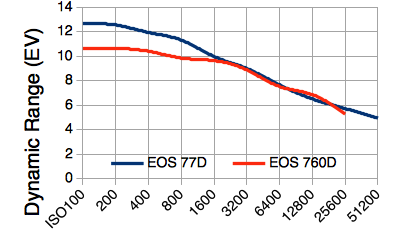
RAW Dynamic range:
Dynamic range is where the EOS 77D’s sensor shows its superiority, with much better results at lower ISO settings.

RAW Resolution at ISO200:
The older 760D appears a fraction sharper but the difference is very small.
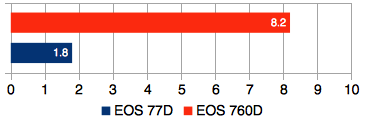
Colour error:
The 77D’s colour rendition is much more neutral than its predecessor’s.
Verdict
The EOS 77D is a very capable DSLR. It does a lot of things well: image quality is very good, while the Live View performance is the best we’ve seen in a DSLR. There’s also the polished touchscreen controls, helpful interface and decent 45-point AF system. However, there’s no 4K video capture, the viewfinder offers only 95% coverage (and it’s a cheaper pentamirror design as opposed to pentaprism) and the plasticky finish doesn’t quite chime with the price right now.
The EOS 77D risks being caught in a kind of no man’s land – if you want an entry-level DSLR the Canon EOS 800D – or even one of Canon’s older but still current models – might be the one to go for, while those looking for something more advanced should spend the extra to get the EOS 80D.
PhotoPlus: The Canon Magazine is the world’s only 100% Canon-focused title on the newsstand. Launched in 2007, for 14 years it has delivered news, reviews, buying guides, features, inspirational projects and tutorials on cameras, lenses, tripods, gimbals, filters, lighting and all manner of photography equipment.
Aimed squarely at enthusiast photographers who use the Canon DSLR or mirrorless camera systems, all content is tailored to Canon users – so everything from techniques to product tests are tailored to those using the EOS camera system.
Editor Peter Travers brings 14 years of experience as both a journalist and professional photographer, with Technique Editor Dan Mold shoring up the magazine with his 6 years of expertise.

